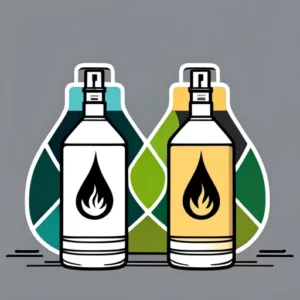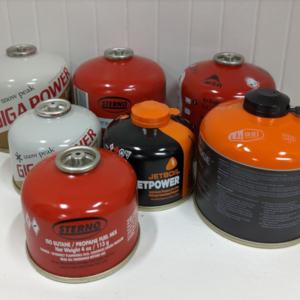What is Isobutane?
Isobutane is the most common canister fuel used around the world today for small lightweight backpacking style canister stoves. Isobutane is a mixture of butane and propane typically around 80% Butane with the remaining 20% propane. This mixture of gases is ideal for a low weight, high performance solution at most temperatures. The industry came up with this elegant solution to address a couple of issues when using only butane or only propane.

The Pros and Cons of Butane and Propane
Butane and Propane each have their pros and cons. Interestingly, they are kind of like opposites which is why they provide an optimum solution for backpacking fuel when mixed together.
Max Pressure & Canister Weight:
Butane has a vapor pressure of <50psi (3.5bar) at 100 degrees F. This is ideal to store in a lower strength and therefore lighter weight canister. Alternatively, propane has a vapor pressure approaching 200psi (13.5bar) at similar temperatures. This requires a higher strength canister which is heavier. So, Butane wins the pressure / canister weight category.
Min Operating Temperature:
The downside to butane is its vapor pressure goes to 0 psig at about 30F (-1C). This means pure butane will not perform once the canister gets around the freezing mark. On the other hand, propane continues to have vapor pressure down to about -40F (-40C). This means propane is a clear winner when it comes to performance at low temperatures.
The Ideal Solution
The majority of canister fuel manufacturers produce isobutane mixtures between 70/30 and 85/15 (Butane/Propane). These mostly butane mixtures provide an ideal weight solution while providing performance to around 15F (-9C) at sea level. However, there are manufactures such as Coleman and Primus that provide fuels specifically for cold weather and claim they can operate -13F (-25C). These ratios must be closer to 50/50 mix.
Temperature Impact on Isobutane Performance
I created the following chart to show the approximate temperatures when isobutane stops performing. Looking at the chart in detail, we can see that the majority of ~80/20 isobutane mixtures will lose vapor pressure and stop performing around 15F (-9C). I provided a range because I found one of the major canister fuel manufacturers indicated their butane percentage can vary +/- 6%; and manufacturers have slightly different, but similar ratios from the start. These variations can impact the temperature performance +/-10F degrees or so. The actual performance loss is somewhere around 3-5psig (0.3bar) because there needs to be some amount of pressure to exit the canister and burn appropriately.
If you need stove performance below 20F (-7C), you should consider using a propane stove, or if weight is important, I recommend a liquid fuel stove to be sure. Check out my post on the pros and cons of canister and liquid fuels.

Altitude Impact on Isobutane Performance
Higher elevation increases the performance of the fuel because the lower atmospheric pressure will lower the minimum operating temperature. You can expect to operate about 10F (-12C) degrees colder at 10,000ft (3000m) elevation. For example: if 10F is the point of pressure loss at sea level then it would be about 0F (-18C) at 10,000 feet. It’s not exactly linear, but a rough rule of thumb would be 1 degree F lower for each 1000ft (300m) elevation assuming a 80/20 mix. However, it is important to remember that high elevations usually come with colder temperatures.
Special thanks to the EngineeringToolbox.com for some of the information provided in this post.







